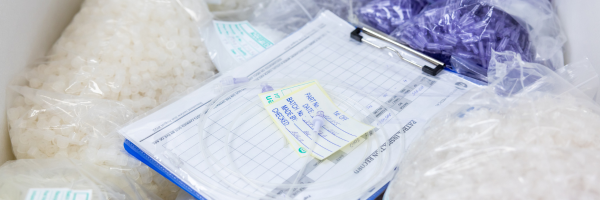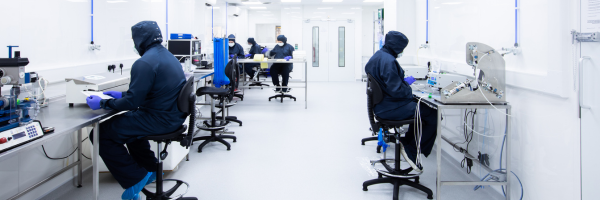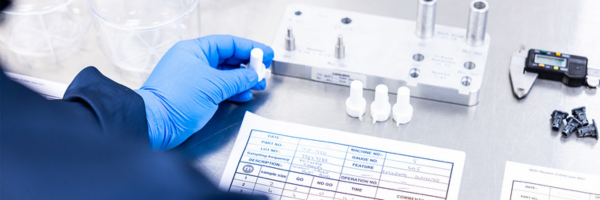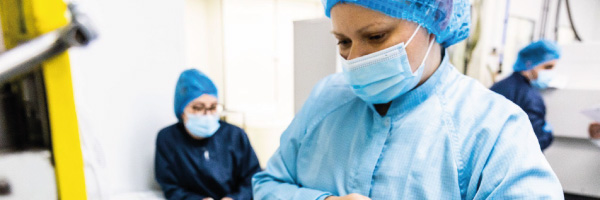
In the fast-paced world of medical device manufacturing, efficiency, precision and cost effectiveness are crucial. Injection moulding stands out as a versatile and highly efficient process that has become central to producing high-quality medical devices. This blog explores the key advantages and disadvantages of injection moulding and how it has transformed the medical device industry.
What is Injection Moulding?
Injection moulding is a precise scalable manufacturing process where molten plastic is injected into a mould to produce complex components quickly and consistently with minimal waste. It allows for the production of clean and biocompatible parts at scale, making it one of the most relied-on methods in medical device manufacturing.
With this foundation in mind, let’s explore the key injection moulding advantages and disadvantages in medical device manufacturing.
Injection Moulding Advantages and Disadvantages
Understanding injection moulding advantages and disadvantages in medical devices is essential for manufacturers seeking both efficiency and compliance.
| Advantages | Disadvantages |
|---|---|
| Precision and consistency | High initial tooling costs |
| Cost-effective for large volumes | Longer lead times for set-up |
| Fast cycle times compared to CNC or 3D printing | Tooling modification can be expensive |
| Customisation and flexibility of production size | Tooling malfunction can be expensive to repair |
| Large number of polymer options available | Tooling is produced to specific material shrinkages so material changes are not always possible |
| Great quality control and validation | |
| Production can be scaled with additional or larger impression tooling | |
| Tooling can often be moved between suppliers |
Key Advantages of Injection Moulding in medical devices
1. Precision and Consistency
Injection moulding is used across many different areas of the medical device sector. It uses medical-grade polymers injected under high pressure into custom moulds to create components accurate to microns. This process is highly repeatable which lowers quality control costs, ensuring patient safety and treatment reliability.
2. Cost-Effective for Large Volumes
In medical device manufacturing, cost-effectiveness is not merely an advantage, it’s a necessity. Injection moulding offers significant financial advantages over machining or casting. It can produce multiple parts per cycle, boosting throughput while minimising waste. The process often requires little to no post-processing, saving time and labour costs. This efficiency supports affordable healthcare solutions by lowering production costs.
3. Fast cycle Times compared to CNC or 3D printing
The speed of production in medical device manufacturing is vital. Injection moulding is particularly advantageous in this regard. The process can have rapid cycle times, often as quick as a few seconds, up to minutes for what would be considered a long cycle time. If your tooling has been configured correctly to your required production volumes thousands of parts can be produced per hour.
4. Customisation and Flexibility of production size
Not only does it allow for the production of complex geometries and internal structures, but the moulds themselves can be produced to incorporate interchangeable inserts such as logos, threads, pin sizes, or fitting changes. Allowing 1 tool to be used for multiple devices. Tooling can also be used for multi colours, or produce a number of different parts in the sample material which can help reduce overall tooling costs.
Manufacturers also have the flexibility to adjust various parameters, from material composition to temperature controls, allowing the tailoring of products to allow for changes between raw material batches.
5. Large number of polymer options available
In the domain of medical device manufacturing, the selection of materials holds particular significance due to the added likelihood of contact with the human body. Injection moulding rises to the challenge by offering compatibility with a large selection of medical-grade materials. These range from biocompatible polymers and thermoplastics to silicone and high-performance resins. Such material diversity provides the flexibility to meet not only sterility and biocompatibility requirements but also offers scope for customising mechanical properties like strength and flexibility.
6. Great Quality control and validation
Stringent quality control is one of the most important aspects of medical manufacturing. One of the most compelling advantages of injection moulding lies in its inherent capability to offer granular control over each step of the production process. From the input material quality to the precision of the mould and the calibration of injection parameters, every element can be rigorously monitored.
Furthermore, state-of-the-art injection moulding machines are equipped with advanced sensor technology and real-time feedback systems. These systems not only facilitate immediate adjustments to ensure optimal performance but also allow for statistical quality control, thereby significantly reducing the risk of defects and waste. Such meticulous quality assurance and validation mechanisms make injection moulding an ideal choice for the exacting standards required in medical device production. Learn more in our Quality Control Guide.
7. Production can be scaled with additional or larger impression tooling
Injection moulding can be adapted from prototype runs to multicavity production. When your component demand is low, smaller single cavity moulds can be used to meet production demand. As the production demands increase, the moulds can be replicated and run at other suppliers, or multi cavity tools can be produced to reduce cycle time, and production cost. Explore our specialist medical manufacturing facilities that make this possible.
Disadvantages of Injection Moulding in medical devices
While there are many advantages in injection moulding, it’s important to understand there are disadvantages and limitations.
1. High Initial Tooling Costs
Creating custom moulds requires an upfront investment that may not suit small production runs or start up companies. However, these costs quickly balance out for medium to large volumes, making injection moulding cost-effective over time.
2. Longer Lead Times for Set-up
Initial set-up, including tool manufacturing and validation, can take time. However, once in place, the process delivers consistent quality at speed. Many manufacturers view this early investment in time as a trade-off for long-term production efficiency and repeatability.
3. Tooling modification can be expensive
Due to the relatively high cost of tooling production, should you need to modify the tooling to make changes to your component, the costs are also comparatively high. Hardened production tooling can take hours to modify, and replacement parts are expensive. It should be noted that modification in most cases is often still cheaper than new tooling, but not in every case.
4. Tooling malfunction can be expensive to repair
Throughout the tools normal life the tooling will inevitably need serving and or repair. Routine serving, cleaning, and replacement parts need to be considered and planned for. The more complex the tooling, the larger the serving bill will be.
Additionally through machine fault, operator error, or just bad luck the tooling may become damaged and parts need to be replaced. These bills can add up quickly.
5. Tooling is produced to specific material shrinkages so material changes are not always possible
Each polymer type will have its own shrinkage rate. The “shrinkage” will be defined on the material data sheet and the tooling manufacturer will need to allow for this when the tool is produced. For example Polycarbonate has a shrinkage of 0.5% to 0.8%, which is considered quite stable. If a part was to be 100mm long the tool would be produced at 100.5mm long based on using a 0.5% shrinkage rate to allow for the plastic to shrink later. If the tool were to be designed to produce a polypropylene part with a shrinkage of 1% to 2.5% the size of the tool would be around 101–102.5mm.
Should you wish to change the raw material for some reason, you would need to choose something with comparable shrinkage, or tooling modification would be required.
Common Medical Applications
Injection moulding’s precision and material versatility make it suitable for a wide range of medical devices and components . Beyond meeting biocompatibility, and repeatability standards, additives such as colours, antimicrobial agents and even smells can be added during moulding, further meeting any intended design specifications.
Typical products include:
- Syringes bodies and plungers
- Cases, housing and precision packaging
- Galipots, procedure trays,
- Luer locks, clamps, push fit connectors
- Custom components, handles, switches, caps, closures
In conclusion
From intricate designs to customisable solutions, the advantages of injection moulding in medical device manufacturing are hard to ignore. As medical technology continues to evolve, this method will undoubtedly continue to play a central role in producing innovative devices and components that improve patient outcomes and contribute to advancements in healthcare globally. For companies seeking to leverage the advantages of injection moulding in medical device production, partnering with an experienced contract manufacturer can ensure both compliance and efficiency. For further insights, read our guide on Injection Moulding and Medical Devices: What You Need to Know.
About Meridian Medical
Meridian Medical is an established and experienced contract medical device manufacturer specialising in a wide range of medical devices. We offer product DFM, regulatory assistance, cleanroom injection moulding, cleanroom assembly, contact packaging and sterilisation management. We have over 30 years’ experience supplying UK and European companies.
To find out more about how Meridian Medical can help you with your medical device manufacture, get in touch today by filling out our online form or contacting us on 01903 732344 or info@meridian-medical.com.
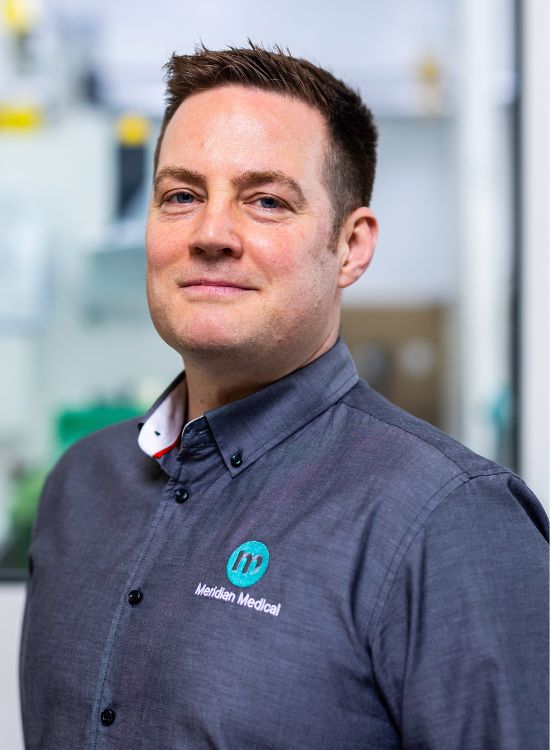
Author: James Fenton, Managing Director
James Fenton, Managing Director of Meridian Medical since 2017, has over 20 years of industry experience. He has been pivotal in developing and producing over 500 types of single-use medical devices, including CE-marked class 2 and 3 devices. With a strong focus on business strategy, project management and customer support, James ensures Meridian Medical's agility and innovation. His expertise is backed by qualifications in Business Studies and Medical Process and Equipment Validation, plus extensive industry training. James's insights into the industry that he has dedicated his entire career to provide a bank of invaluable information aimed at increasing knowledge of and driving advancements in medical device manufacturing.

